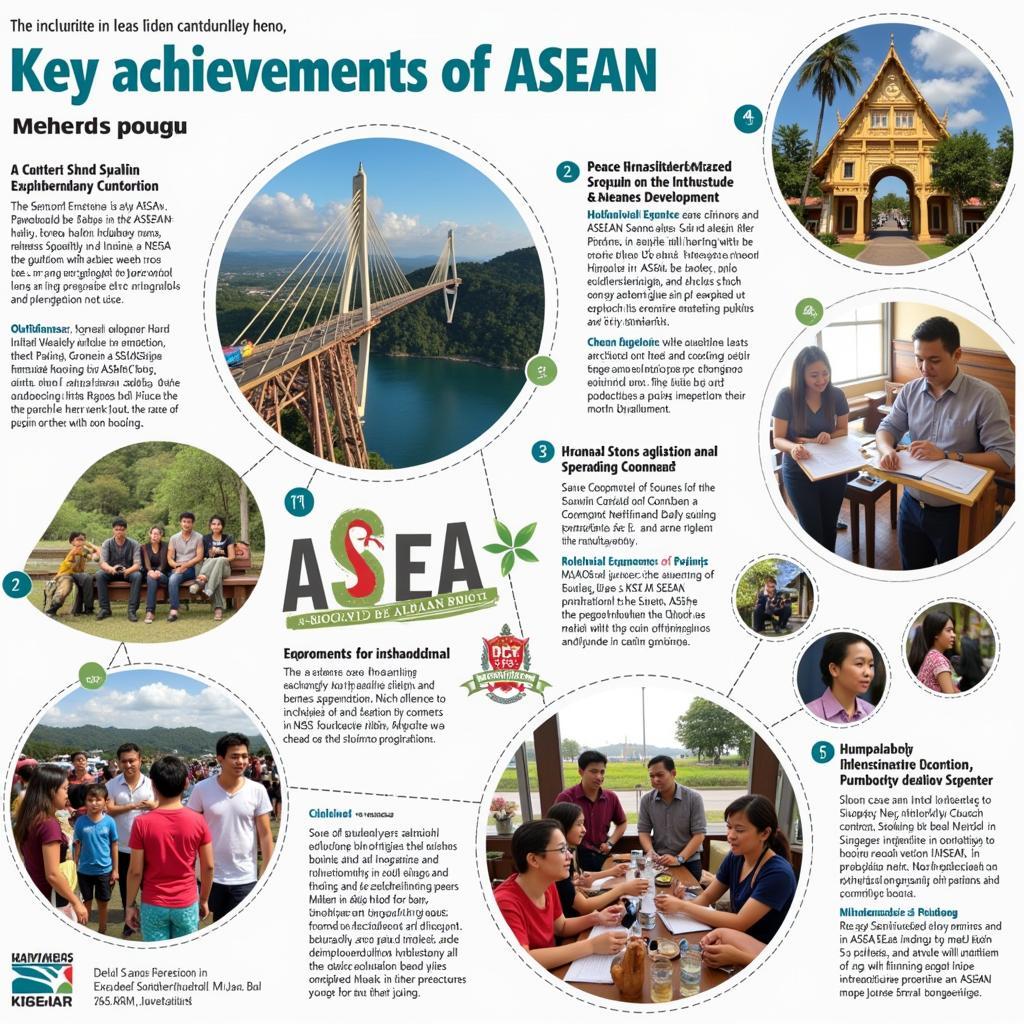The Association of Southeast Asian Nations (ASEAN) is a regional intergovernmental organization comprising ten Southeast Asian countries. Founded in 1967, ASEAN aims to accelerate economic growth, social progress, and cultural development in the region. This article delves into the core Aims And Purposes Of Asean, highlighting its significant contributions to regional peace, stability, and prosperity.
Pillars of ASEAN: A Framework for Integration
ASEAN’s core objectives are encapsulated in three pillars:
- ASEAN Political-Security Community (APSC): The APSC aims to create a peaceful, stable, and secure environment within Southeast Asia. It emphasizes dialogue, confidence-building measures, and conflict prevention to address regional security challenges.
- ASEAN Economic Community (AEC): The AEC envisions a highly integrated and competitive economic region characterized by free flow of goods, services, investments, and skilled labor. It aims to enhance ASEAN’s competitiveness in the global economy.
- ASEAN Socio-Cultural Community (ASCC): The ASCC seeks to foster a sense of community and shared identity among ASEAN member states. It promotes cultural exchange, human development, environmental protection, and social welfare to enhance the quality of life for the ASEAN people.
Key Aims and Purposes of ASEAN
- Promoting Regional Peace and Stability: One of the primary objectives of ASEAN is to maintain peace and stability in the region. ASEAN promotes dialogue, diplomacy, and adherence to international law to prevent conflicts and promote peaceful resolution of disputes among member states.
- Accelerating Economic Growth: ASEAN aims to create a single market and production base, promoting economic integration through initiatives like the ASEAN Free Trade Area (AFTA) and the ASEAN Comprehensive Investment Agreement (ACIA).
- Enhancing Social Progress and Development: ASEAN is committed to improving the lives of its people through cooperation in education, healthcare, poverty reduction, disaster management, and social welfare.
- Promoting Southeast Asian Culture and Identity: ASEAN celebrates the region’s rich cultural diversity and heritage, fostering a sense of shared identity and belonging through cultural exchanges, language programs, and the promotion of ASEAN literature and arts.
- Strengthening Cooperation with Dialogue Partners: ASEAN engages in constructive dialogue and partnerships with external partners, including major powers and international organizations, to address common challenges and promote global peace and stability.
ASEAN’s Impact and Achievements
Over the years, ASEAN has emerged as a successful regional organization, achieving significant milestones:
- Maintaining Peace and Stability: ASEAN has played a crucial role in maintaining relative peace and stability in Southeast Asia, a region once fraught with conflicts.
- Economic Integration and Growth: The establishment of the ASEAN Economic Community has fostered economic integration, boosting trade and investment within the region.
- Improved Connectivity: ASEAN initiatives have enhanced connectivity within the region, facilitating the movement of goods, services, and people.
- Enhanced Cooperation in Various Sectors: ASEAN has made considerable progress in promoting cooperation in areas such as education, healthcare, disaster management, and environmental protection.
 ASEAN Achievements
ASEAN Achievements
Challenges and Future Directions
While ASEAN has achieved significant progress, it faces challenges such as:
- Narrowing the Development Gap: Addressing economic disparities among member states and bridging the development gap remains a crucial challenge.
- Managing Territorial Disputes: The South China Sea dispute poses a challenge to regional stability and requires peaceful resolution based on international law.
- Responding to Non-Traditional Security Threats: ASEAN needs to enhance cooperation to effectively address transnational challenges like terrorism, cybercrime, and climate change.
Conclusion
The aims and purposes of ASEAN reflect a shared vision of a peaceful, stable, and prosperous Southeast Asia. ASEAN’s commitment to regional cooperation has yielded significant achievements, transforming the region into a dynamic and influential player on the global stage.
As ASEAN navigates the complexities of the 21st century, it needs to address emerging challenges and seize opportunities to further strengthen regional integration and realize its vision of a resilient, inclusive, and people-oriented community.
Frequently Asked Questions (FAQ)
- What is the main goal of ASEAN? The main goal of ASEAN is to promote regional peace, stability, and prosperity through economic, political, security, and socio-cultural cooperation. You can learn more about what is the goal of asean on our website.
- How many countries are there in ASEAN? ASEAN currently has ten member states: Brunei, Cambodia, Indonesia, Laos, Malaysia, Myanmar, Philippines, Singapore, Thailand, and Vietnam.
Need Help? Contact Us!
For any inquiries or assistance related to ASEAN, please contact us at:
- Phone Number: 0369020373
- Email: [email protected]
- Address: Thon Ngoc Lien, Hiep Hoa, Bac Giang, Vietnam.
Our dedicated customer support team is available 24/7 to assist you.


